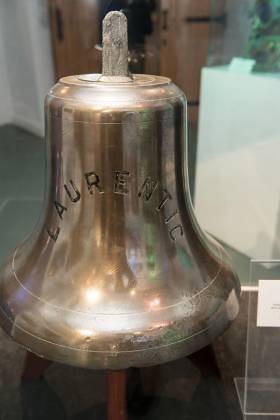Displaying items by tag: Bell On Display,Derry
White Star Line's S.S. Laurentic Bell Makes Homecoming Voyage to Derry
#HistoricBoats - The bell of S.S. Laurentic, one of the most significant artefacts in local maritime history, will make its return to the Derry this week, following purchase at auction by Derry City and Strabane District Council.
The Bell, which was desperately rung by crew as the immense former White Star liner sank in the Lough Swilly, Co. Donegal over a century ago, will go on display at the Guildhall from today, Friday 12 January, before it finds a permanent home as Afloat previously reported in a planned Maritime Museum due to open in 2020 at Ebrington Square.
Curator with Council’s Museums and Visitor Services, Roisin Doherty said she looked forward to seeing the Bell making its return. “We are delighted to display the Laurentic bell once again, particularly in the Guildhall, where the survivors of the wreck were treated to a meal by the Mayor of the city in 1917. The tragic story of the sinking of the vessel is inextricably linked with the city and this is a fantastic way to ensure the legacy of the ship survives in memory.”
The display will be accompanied by an exhibition entitled ‘Letters from The Laurentic’, which chronicles the story of the Laurentic disaster through deeply personal correspondence, through letters, postcards and photographs of the men lost and those, fewer in number, who survived. A short documentary, ‘Wine Dark Sea; Letters from The Laurentic’, will also feature.
The exhibition was commissioned by the Ulster Canada Initiative and produced by Harry Kerr, Martha McCulloch, Jim Doherty and Don McNeill.
The Laurentic Bell is made from bell alloy and is from the Bridge area of the ship. It was found in 1979 by local diver Ray Cossum and his son Des with Allerton Salvage. It weighs 37kg and is 2ft high by 2ft wide at the base. It is one of only two bells from the ship, the other being the bow bell, which is permanently located in the belfry of the Church of Ireland at Portsalon, after being donated by the leader of the original Royal Navy salvage expedition in 1924.
In addition to being a highly important historic artefact recovered from the wreck, the bell is also significant because of a series of dents on its rim. These dents were created by a sailor on the bridge, who on the orders of the captain, beat the bell with a wrench to sound the alarm to abandon ship. The survivors of the wreck were afterwards acknowledged by the then Mayor of Londonderry, Alderman R.N. Anderson, and were beneficiaries of a large scale city-wide relief effort and treated to a meal in the Guildhall.
As referred above the bell exhibition will be on display in the Guildhall from today and continue to Wednesday, 24 January.
























































